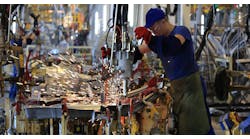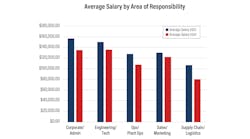Regular readers of my column know that I don’t classify logistics, warehousing and material handling as progressive supply management processes. It bothers me that a large percentage of people in the profession think they are. I know that my perspective can be viewed as blasphemy by those companies that have invested a lot of money in expensive, sophisticated software in attempts to better manage these functions.
I regard these functions as Band-Aids needed to cover-up blunders associated with sourcing decisions. Specifically, errors are made in sourcing when decisions are based primarily on piece-price rather than on the total cost involved in working with specific suppliers. And, for instance, supplier-specific costs associated with managing logistics are seldom taken into account when sourcing.
For instance, when I started working with the company I would the majority of my overall career with, it had a corporate supervisor (not VP, director or manager) of logistics, with a very small group of direct reports primarily associated with scheduling. The cost of maintaining that group is dwarfed by the company’s present cost of maintaining its mega-department and software investments.
I often use Japanese automobile manufacturers as example of companies that understand the piece-price vs. total cost equation. I once benchmarked a Japanese car manufacturer and found out that 96% of their annual purchases were within 200 miles of their assembly plant. Along with this. I learned that they:
- Needed minimal resources—including software—to manage supplier logistics.
- Required no warehousing outside of their manufacturing facility to hold pre-built, pre-positioned supplier parts.
It is well known that Japanese automobile manufacturers only need about one-half—50 to 60 days—of the dealer stock inventory to support Customer Fill Rate goals compared to domestic car companies, who need 90 days and up. Why? Because those U. S. automobile manufacturers have pretty much been “all in” for sourcing overseas, chasing lower piece-prices. You can make up your own minds. Either companies like Honda or Toyota don’t really understand sourcing’s impact on overall manufacturing costs, or they do. What do you think? How many days of pre-built inventory does your employer need to maintain its Customer Fill Rates?
Think of all of the ads you see for industry related software products on the market. A large portion of them are related to optimizing logistics, warehousing and material handling. On the other hand, I have seen very few that promote facilitation of supplier collaboration. In my mind, this is because many large corporations now seem to favor leveraging suppliers rather than collaborating with them.
You can see from the above that working with long-distance suppliers can cost a lot more than what is captured in piece-prices. You only check financial statements—including executive-level metrics—to see that there are many supplier related costs hidden in general overhead accounts. However, these are not normally assigned to specific suppliers when making sourcing decisions.
Read more of Paul Ericksen's supply chain management articles
I get a lot of contacts from companies that want me to tout their products in my articles. I am open to this if they support IndustryWeek’s primary Supply Chain Initiative; i.e., increasing visibility of the higher value increased supplier-customer collaboration can deliver.
Out of these contacts, I have recently been introduced to two products that can be used for this. While I am no shill for any manufacturer, I think it is a good fit with our initiative to highlight such tools. The first of these tools will be described below. The second will be the topic of my March 15 column.
Reducing the Cost of Quality Management
Elemica’s supply chain software tool aligns very closely to an initiative I worked on back in the day. Specifically, changing our factory’s supplier quality assurance strategy. This required three steps. First, to confirm that supplier’s measurements of part specs aligned statistically with the measurements we’d get if we measured the parts internally. Second, to require strategic suppliers to base their quality programs on process capability evaluation and documentation rather than part inspection. Finally, turning over all responsibility for the quality of purchased parts to the suppliers themselves. Based on this—for all intents and-purposes—our factory was able to eliminate the Receiving Inspection function and lower supplier costs associated with ensuring they were shipping in-spec parts to us.
If you’d like to read about this initiative, it is described in a 2019 article I wrote, entitled “Sharing the Quality Love.”
Our purchase back then were primarily comprised of discrete, physical parts. Elmica’s software uses the same approach we used, but for continuous process fluid flows. The concept is simple but powerful, as follows:
1. Electronically collect, compare and give real-time visibility to supplier inspection records and those coming from Receiving Inspection. This both reduces the time involved in manually collecting and inputting data for evaluation. This does not add work to what is already happening as suppliers typically inspect shipments prior to delivery and customers typically inspect parts prior to using them in production.
2. Based on a complete running history, statistically compare the data from the two sources to establish whether or not supplier measurements match that of the customer. The measurement focus is primarily CpK and R-Chart evaluation of a solution’s percentage of component chemicals. Again, this is visible to each party in real time and can be the basis for supplier better aligning their measurement capability to the customer’s.
3. Over time the customer will gain confidence such that they can reduce and eventually eliminate the costs and time associated with inspecting the solutions upon receipt. Suppliers will also have valuable real time data to give them insight into whether their processes remain on-target and in-control.
4. Greatly reduced Supplier Corrective Action Requests and, when defects do occur, since a significant amount of data is available to support Root Cause Analysis.
5. The OEM can used this data to compare those specific quality assurance related costs associated tied to doing business with specific suppliers. This can be the basis of future sourcing decisions.
6. The data can also be generically shared between suppliers so that they see where they stand on a competitive basis, giving them incentive to improve their processing.
There may be other products that I am not aware of that provide similar capabilities.
Paul Ericksen is IndustryWeek’s supply chain advisor. He has 40 years of experience in industry, primarily in supply management at two large original equipment manufacturers.




